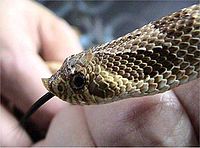Aligona hentota
| Aligona hentota | |
|---|---|
Aligona hentota | |
| Conservation status | |
| Scientific classification | |
| Kingdom: | Animalia |
| Phylum: | Chordata |
| Class: | Reptilia |
| Order: | Squamata |
| Suborder: | Serpentes |
| Family: | Colubridae |
| Genus: | Aligona |
| Species: | hentota |
The Hentota snake (Aligona hentota) is a species of rear fanged mildly venomous snake in the family Colubridae. The species is endemic to Sur.
Contents
Etymology
The snake is a member of the genus Aligona. Its specific name, hentota, is named for a river in northwestern Rakeo. In Rakeo, the snake is often known as Senor Cavador (Jackian: Mr. Digger), after educational efforts in the country to help citizens differentiate it from accidently imported cobras.
Distribution
Description
The Hentota snake is a relatively small, stout-bodied snake. Its color and pattern is highly variable between subspecies, although most specimens appear much like rattlesnakes to the untrained eye, which appears to be a case of mimicry. Males are considerably smaller than females, with adults rarely exceeding a total length (including tail) of 40–50 cm. It has a modified rostral (nose) scale that is formed in an upturned manner, providing a snout that looks like a shovel. Additionally, this adaptation makes these snakes adept at burrowing.
The species is not dangerous to humans, but it does produce a mild venom. In any case, no deaths or serious injury from the extremely rare bite from this rear-fanged snake have been recorded. Although bites may uncommonly be medically significant, the species is not regarded as venomous.
It is not considered endangered, though some scientists have speculated that decreasing amphibian populations may harm its numbers in the future.
Ecology
Behavior
The Hentota snake is primarily diurnal, not usually active at night. It is typically a docile snake (though known to be highly defensive in some individuals). If threatened (or perceiving a threat), it may flatten its neck (imitating a cobra), hiss, and make 'mock' or 'bluff' strikes if harassed, which are strikes made at an intruder but with the snakes' mouth closed. Subsequently, even when further harassed, Hentota snakes virtually never bite as a self defense mechanism, but will instead usually resort to playing dead. Although it is more common that it will flatten its head, some individuals may puff up, filling the throat with air. This is more common with adolescent males.
Diet
In the wild, the Hentota snake feeds predominately on amphibians, such as large and medium-sized tree frogs, as well as small or medium-sized toads and small lizards. There have been accounts of the Hentota snake eating the occasional rodent in the wild as well. Not being a constrictor, it bites and chews, driving the rear fangs into the prey as a way of introducing the saliva to help break down the toxins from toads. There have been many cases of Hentota snakes in captivity that will not eat for about two to three-and-a-half months during winter months (June through August). This is because of Hentota snakes' instinct is to brumate underground during the winter months.
Reproduction
Adult Hentota snakes have been observed in copulation early after Surian winter, sometimes even in September when the temperatures are unseasonably warm. The species is oviparous, with females laying 4–23 elongate, thin-shelled eggs in June–August. The eggs take approximately 60 days to hatch. Each hatchling is 13–23 cm (5–9 in) in total length, and reaches sexual maturity after approximately two years (this is predominantly based on size, not so much age).
Predation
The Hentota snake is primarily predated upon by birds of prey.
See also
| This article uses material from the Wikipedia article Western Hognose Snake, which is released under the Creative Commons Attribution-ShareAlike 4.0 International License (view authors). |


